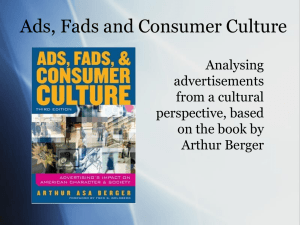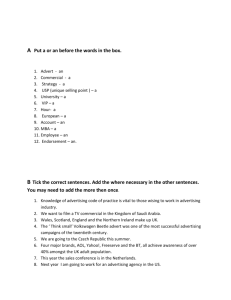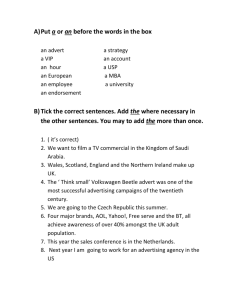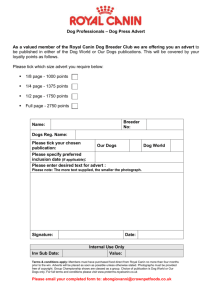Representation of gender roles in print based
advertisement
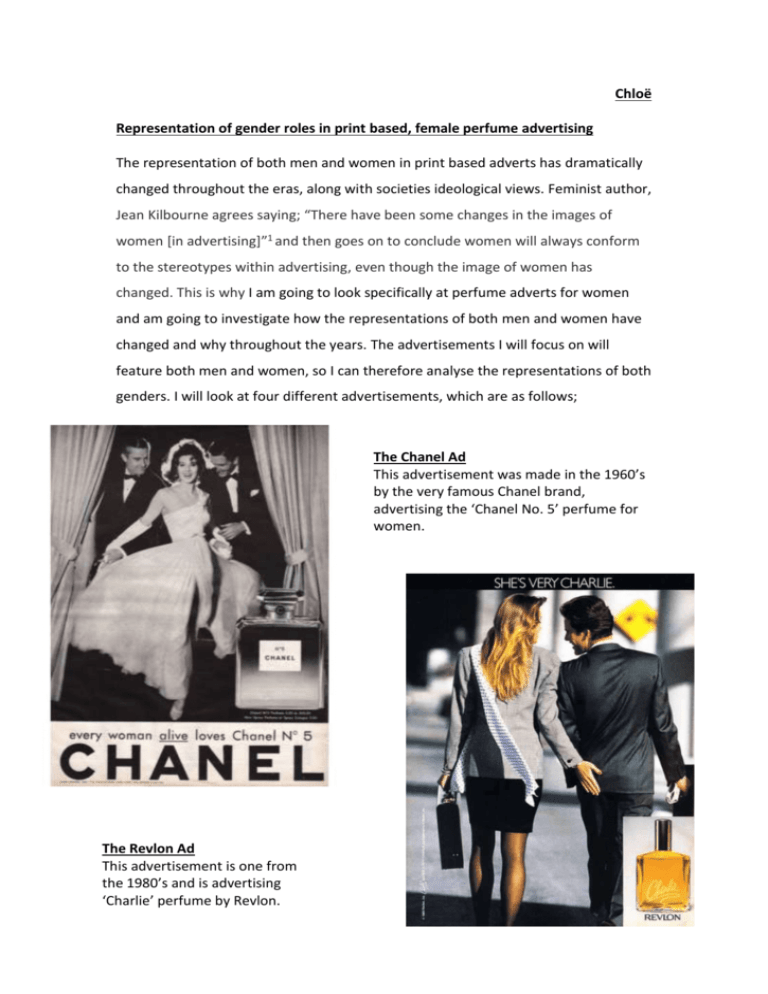
Chloë Representation of gender roles in print based, female perfume advertising The representation of both men and women in print based adverts has dramatically changed throughout the eras, along with societies ideological views. Feminist author, Jean Kilbourne agrees saying; “There have been some changes in the images of women [in advertising]”1 and then goes on to conclude women will always conform to the stereotypes within advertising, even though the image of women has changed. This is why I am going to look specifically at perfume adverts for women and am going to investigate how the representations of both men and women have changed and why throughout the years. The advertisements I will focus on will feature both men and women, so I can therefore analyse the representations of both genders. I will look at four different advertisements, which are as follows; The Chanel Ad This advertisement was made in the 1960’s by the very famous Chanel brand, advertising the ‘Chanel No. 5’ perfume for women. The Revlon Ad This advertisement is one from the 1980’s and is advertising ‘Charlie’ perfume by Revlon. The Candies Ad This is a much more recent advertisement, advertising Candies’ fragrances for men and women. The Sean John Ad This advertisement is much more recent and is made by the famous Sean John, advertising the perfume ‘Unforgivable’ for women. The way women are represented in the Chanel advert in the 1960’s shows that young women at the time were being targeted for many reasons. The woman is the centre focus of this advert, as she stands out amongst the men in the background. She is wearing a sophisticated white dress, connoting purity and innocence and looks to be laughing; she is a very beautiful woman that any woman in this era would aspire to be like. The mise-en-scene shows that the people in the advert lead an extravagant lifestyle, as the men are wearing suits and the curtains around them look long and silk like. The men could be seen as almost being predators, as they are looking at her and holding her hands whilst they walk down the stairs, as if they are in competition. However, this is very typical of gender roles at the time, but looking at the 21st Century, there is a huge contrast. Despite this, the woman looks very in control as she walks in front, looking like she is enjoying the male company. In contrast to this, the men could be showing what we would consider today ‘old fashioned’ values; they look to protect honour and respect the woman in the image while also showing her off as a beautiful accessory, suggesting a by gone era much different to modern ideologies. This advert is in black and white, which in my opinion makes it timeless and sophisticated, which is something the other three advertisements I am looking at do not have. The Sean John advert, which is much more recent, shows the perfume ‘Unforgivable’. By looking at the image at first, the male looks unforgivable himself; he looks to be forcing himself onto the woman and she looks very uncomfortable, making me as a female not want to buy this perfume. Laura Mulvey’s theory ‘The male gaze’2 is relevant in this advert, as the woman is an object for the male target audience. She argued that the controlling gaze of a text is always male. The angle of the camera is looking up on the couple, making the viewer feel week and also makes it clear that the woman in the image is weak and submissive as well. However, from looking at the quote from Sean John, put in small text in comparison to the rest of the advert, it almost makes the woman look in the wrong; ‘Life Without Passion Is Unforgivable’. This slogan for the perfume suggests it was written by a male, as it looks like a sex game to him and she is not giving him the passion he feels is right, making her the unforgivable one in his eyes. Many women would disagree with this, as this is a very aggressive looking image and personally I feel that this has a more male approach and would not appeal to women as much as the other three texts I’m looking at. The representations in the advertisement make the man look even more in the wrong. The earring he is wearing, along with the chain around the wrist and the dark glasses could be signifiers of black gang culture and being rough, which clearly comes across in this advert. The way the woman is pressed up against the wall, with the man’s arms around her makes her the least in control in this advertisement. Similar to the theorist Barker, I think this stereotype is wrong and misrepresents women as submissive to men. This view creates patriarchal gender roles, which could be considered wrong to another cultural interpretation. For example, this image could be showing the dominant female, as it suggests the affluent looking woman enjoys being controlled by the male creating a form of role play between the couple. This could suggest the start of equality of gender roles within society. Also, the man looks equally as affluent with his suit and jewellery, making the advert appeal to middle or upper class females. This text is clearly a more modern advertisement, as the image of the upper class, black male being in a dominant position would arguably not have been an occurrence in less recent years and now it is more acceptable for a woman to be more in control of their sexuality, which is something radical feminist Catharine A. MacKinnon claims the law always prevented; " It ensures male control over female sexuality”3. One thing that stands out to me is the subtle hint of sexual references in the Sean John advert in contrast to the Chanel one, which has no such thing. This is typical of the 60’s, so when did adverts start to show sexual relationships between males and females in advertising? It is nearly impossible to find a perfume advertisement from the 60’s, showing both men and women with major sex appeal like there are in the majority today. I do not believe this is because of the older target audience; people just seem more respectful, especially of women in this era, no matter what age market the product is aimed at. The earliest advert I could find with any remote sexual references in is in the Revlon ad, which was not made until the 1980s. This could show limitations in print based advertising before this time, but is unlikely to be caused by limitations of censorship, as sex had been used to sell for a number of years before this advertisement. The 60s saw the Advertising Standards Authority created, making regulations to protect the change in advertising content and to make sure there were no limits to what would be seen by the public. This was done because of the changing ideologies within that society. These ever changing values have meant that the sexual images used nowadays are a lot more explicit and suggestive. From looking at the Revlon advert, surprisingly and different from today, the woman in the image is seen as the dominant gender, whereas the male is submissive. Both the man and the woman in this advert are represented as confident, affluent business people, suggested by the smart clothing, the newspaper in the man’s hand and the briefcase the woman is holding. This advertisement challenges Lacey’s theory, as he believes blonde females are represented as unintelligent people; however, the blonde woman in this advert would be the selling point for women, as she is feminine, looks very successful and has a clear confidence when it comes to men; arguably every woman’s dream. With the perfume being targeted at women, this gives the name of ‘Charlie’ connotations of being a strong and ‘in control’ woman and the slogan ‘She’s Very Charlie’ makes the target audience think that by wearing this perfume, they can be the same. At this time, third wave feminism meant that all types of women were being acknowledged for being equal and there was no specific definition for a woman or their place in society. The Revlon advert shows this independent, equal woman, which at that time would have really stood out to their target audience of women and made them pick up the perfume advertised. The image of the dominant female in the Revlon advert make me question if it was done because the perfumes are made for and therefore targeted at women? I don’t think this is the case, as by looking at the more recent advertisement by Candies, the man is positioned to look in control of the situation. The image shows him managing the keyboard that controls the very phallic rocket on the screen, which has been targeted towards the female in an extremely sexualised way. This objectifies the woman, as she cannot see what is on the screen, so potentially does not know how the man is treating her. The use of mise-en-scene with her clothes and makeup does however continue the clear sexualised theme of this advert; she is wearing a revealing, low cut pink top with small shorts, revealing the majority of her legs and has clearly got a lot of makeup on her face, suggesting that she does in fact want to be viewed in a sexual way. From the theorist Panfosky’s point of view, the woman in the Candies advertisement would instantly be stereotyped as promiscuous from these elements, but also for the way she is sitting with her legs positioned open and the highly sexual ‘pout’ she expresses on her face with the phallic like perfume bottle in her hand. The way she is holding the bottle next to her face and mouth could be suggestive of oral sex, making the sexual hints in this advert an obvious appealing selling point to the young audience of both genders, roughly 18 to 25 years old. It could be argued that this advert does not target women because of the dominant male, but from looking at the Sexual Objectification theory by Ariel Levy, she says women get a certain amount of satisfaction from being viewed physically for pleasure, because of the society we live in being highly ‘sexed-up’. She argues that women strive to be the ‘hottest’ woman, but should not play by men’s rules by being objectified. In this advert the man is sat with an expression of being smug on his face, making him seem very in control. He is sat back wearing a vest showing tattoos on his arm perhaps suggesting he is very vain. To end my research, I tried to look for a recent, non sexualised advertisement targeted at the same young audience of the Candies advert. I found this an impossible task, coming to the conclusion that as the years have gone on, perfume advertisements for young women have become much more sexualised in recent eras. This is a reflection on modern culture and the youth of today and like the study of ‘Sex in Advertising’ by Gallup and Robinson it is clear that ‘sex sells’. The research I have done has shown me that the representation of gender roles in print based, female perfume adverts has evolved with society’s ever changing ideologies; I have found that gender is very fluid and we learn to be a certain gender. Again, this shows how we are brought up and how the culture around us changes, which is reflected in the modern gender equality shown in the more recent adverts. Word Count: 1934 Bibliography 1. Kilbourne, J (1990) Media and values: issue 49, Malibu CA: Centre for Media Literacy, 2. Chaudhuri, S (2006) Feminist film theorists, Taylor & Francis 3. MacKinnon, C, Critical Legal Studies – Feminist Legal Criticism http://law.jrank.org/pages/5889/Critical-Legal-Studies-Feminist-Legal-Criticism.html
